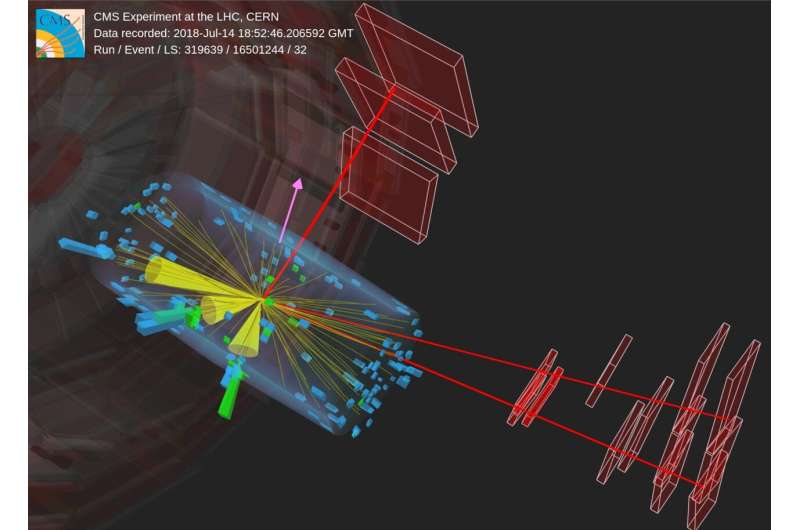Science
CERN Detects First-Ever Single Top Quark with W and Z Bosons

The CMS collaboration at CERN has achieved a groundbreaking milestone by observing the production of a single top quark alongside a W and a Z boson. This rare event, known as tWZ production, occurs only once in approximately every trillion proton collisions at the Large Hadron Collider (LHC). The finding represents a significant advancement in particle physics, potentially offering new insights into the fundamental forces that govern the universe.
Unraveling Rare Events
The discovery of tWZ production is akin to finding a needle in a haystack the size of an Olympic stadium. Observing this process provides a unique opportunity for physicists to study the interaction of the top quark with the electroweak force, which is mediated by the W and Z bosons. As the heaviest known fundamental particle, the top quark interacts most strongly with the Higgs field, making its study critical for understanding the Higgs mechanism.
The tWZ process is particularly valuable because it may reveal signs of new phenomena and physics that extend beyond the current Standard Model. Despite its importance, observing tWZ production poses significant challenges due to its rarity and complexity. This process closely resembles another known as ttZ production, where a top and an anti-top quark are produced alongside a Z boson. Since ttZ production occurs approximately seven times more frequently than tWZ production, researchers face considerable background noise that must be analyzed to isolate the desired signal.
Advanced Techniques for Detection
Alberto Belvedere, a researcher with the CMS collaboration at DESY, emphasized the need for sophisticated analysis techniques to successfully observe tWZ production. “Because of its rarity and its similarity with the ttZ process, observing tWZ production requires advanced analysis techniques involving state-of-the-art machine learning,” he stated. Using these algorithms, the team was able to distinguish the tWZ signal from the substantial background data.
The results have been made publicly available on the arXiv preprint server, revealing that the observed rate of tWZ production was slightly higher than theoretical predictions. According to Roman Kogler, also from the CMS collaboration, “If there are unknown interactions or particles involved, the observed deviation between the measured rate of tWZ production and the prediction would rapidly become larger with increasing energies of the outgoing particles, an effect that is unique to the tWZ process.”
As research continues, future data and analysis will determine if this deviation is simply a statistical anomaly or an indication of new physics. For now, this discovery marks a significant achievement for the CMS collaboration and the ongoing work at the LHC, demonstrating its capacity to uncover nature’s most elusive secrets.
The implications of this observation extend beyond theoretical physics, as it may pave the way for future discoveries that could reshape our understanding of the universe. With the potential for new interactions and particles, the tWZ production event is a reminder of the exciting possibilities that lie ahead in the field of particle physics.
This groundbreaking observation represents an important step in the quest to comprehend the fundamental forces of nature and the underlying structure of the universe.
-

 Science3 weeks ago
Science3 weeks agoResearchers Challenge 200-Year-Old Physics Principle with Atomic Engines
-

 Politics1 week ago
Politics1 week agoHamas Chief Stresses Disarmament Tied to Occupation’s End
-

 Top Stories1 week ago
Top Stories1 week agoFederal Agents Detain Driver in Addison; Protests Erupt Immediately
-

 Science1 week ago
Science1 week agoOhio State Study Uncovers Brain Connectivity and Function Links
-

 Entertainment1 week ago
Entertainment1 week agoSyracuse Stage Delivers Lively Adaptation of ‘The 39 Steps’
-

 World3 weeks ago
World3 weeks agoGlobal Military Spending: Air Forces Ranked by Budget and Capability
-

 Politics3 weeks ago
Politics3 weeks agoNHP Foundation Secures Land for 158 Affordable Apartments in Denver
-

 Lifestyle1 week ago
Lifestyle1 week agoTrump’s Push to Censor National Parks Faces Growing Backlash
-

 Politics1 week ago
Politics1 week agoNFL Confirms Star-Studded Halftime Show for Super Bowl LVIII
-

 World1 week ago
World1 week agoBoeing’s Aircraft Production: Assessing Numbers and Challenges
-

 Top Stories1 week ago
Top Stories1 week agoWill Smith Powers Dodgers to World Series Tie with Key Homer
-

 Health3 weeks ago
Health3 weeks agoNeuroscientist Advocates for Flag Football Until Age 14









